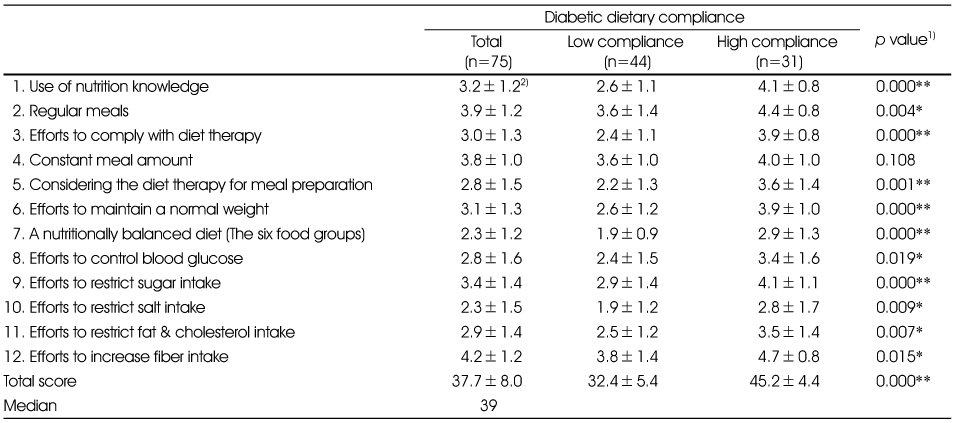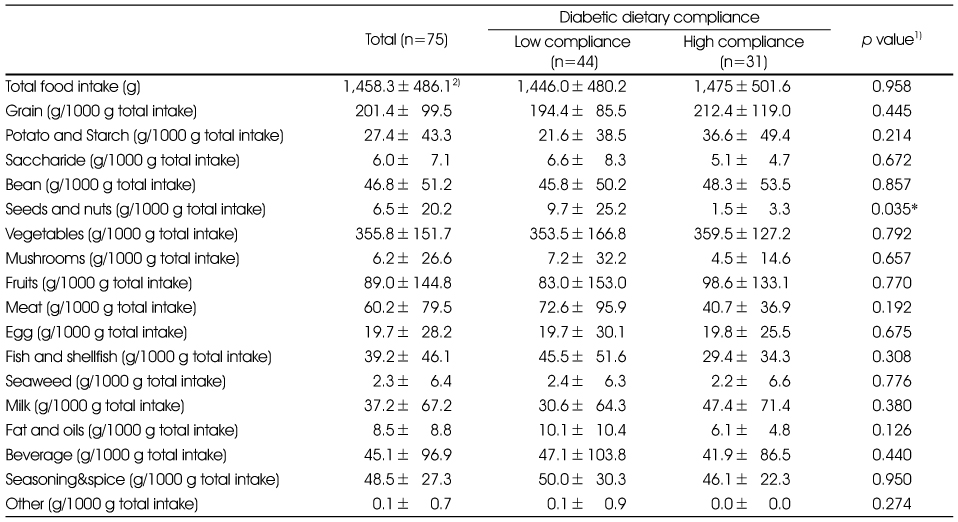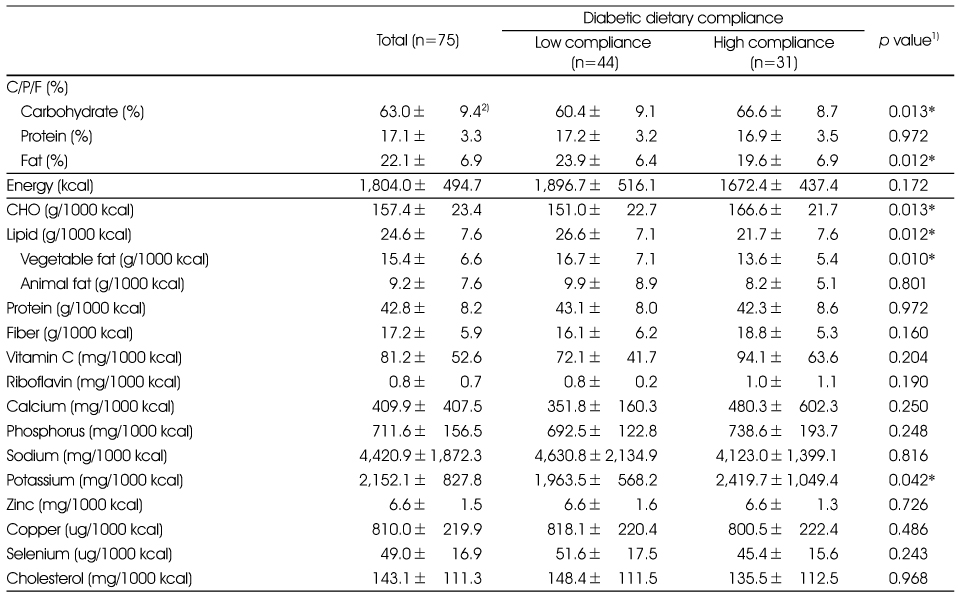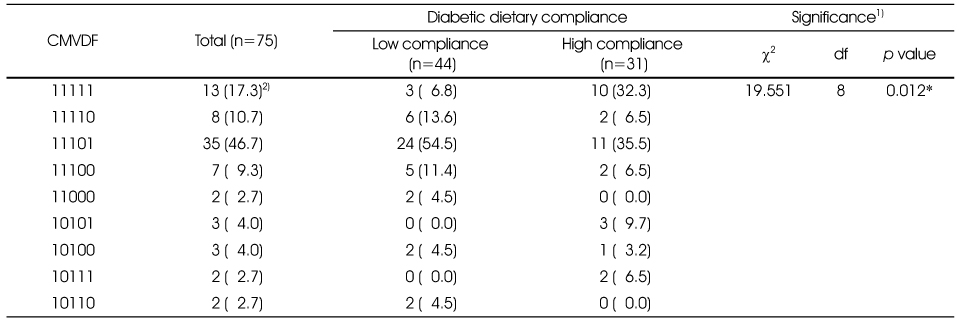Articles
- Page Path
- HOME > Korean J Community Nutr > Volume 20(5); 2015 > Article
-
Research Article
- The Relations between Diabetic Dietary Compliance, Dietary Intake, and Physical Activity and the Prevalence of Metabolic Syndrome (MS) in Type 2 Diabetic Patients
- Dong Eun Kim, Seung Hee Hong, Ji-Myung Kim
-
Korean Journal of Community Nutrition 2015;20(5):351-361.
DOI: https://doi.org/10.5720/kjcn.2015.20.5.351
Published online: October 31, 2015
1Department of Clinical Nutrition, The Graduate School of Public Health, Shinhan University, Gyeonggi, Korea.
2Food and Nutrition Major, Division of Food Science and Culinary Arts, Shinhan University, Gyeonggi, Korea.
- Corresponding author: Ji-Myung Kim. Food and Nutrition Major, Division of Food Science and Culinary Arts, Shinhan University, 95, Hoam-ro, Uijeongbu-si, Gyeonggi 11644, Korea. Tel: (031) 870-3515, Fax: (031) 870-3519, kjm@shinhan.ac.kr
Copyright © 2015 The Korean Society of Community Nutrition
This is an Open-Access article distributed under the terms of the Creative Commons Attribution Non-Commercial License (http://creativecommons.org/licenses/by-nc/3.0/) which permits unrestricted non-commercial use, distribution, and reproduction in any medium, provided the original work is properly cited.
- 945 Views
- 6 Download
- 4 Crossref
Figure & Data
REFERENCES
Citations

- Effects of Depression, Patient Activation, and Family Support on Patient Role Behavior of Elderly Patients with Diabetes Mellitus
Jeong Hyun Park, Jung Suk Park
Journal of Korean Academy of psychiatric and Mental Health Nursing.2024; 33(4): 355. CrossRef - The Relationship between Meal Regularity and Oral Health and Metabolic Syndrome of Adults in Single Korean Households
Jin-Ah Jung, Hye-Won Cheon, On-Ju Ju
Journal of Dental Hygiene Science.2021; 21(3): 185. CrossRef - Effect of Nutrition Counseling by Nutrition Care Process on Diet Therapy Practice and Glycemic Control in Type 2 Diabetic Patients
Tae-Jeong Bae, Na-Eun Jeon, Soo-Kyong Choi, Jung-Sook Seo
Korean Journal of Community Nutrition.2020; 25(3): 214. CrossRef - Healthy Dining Out in Diabetic Patients
Hae-Young Lee
The Journal of Korean Diabetes.2017; 18(4): 264. CrossRef
The general characteristics of the study subjects
1) Analyzed by Chi-square test
2) N (%)
3) Mean±SD
4) Independent t-test
*: p < 0.05
Diabetic dietary compliance score according to the regimen practice of diabetics
1) Analyzed by general linear model (adjusted for sex)
2) Mean±SD
*: p < 0.05, **: p < 0.001
The level of physical activity according to the regimen of practice of iabetics
1) Analyzed by Chi-square test
2) N (%)
3) Mean±SD
4) Analyzed by general linear model (adjusted for sex)
*: p < 0.05
Comparison of food intake per 1,000 g according to the regimen of practiceof diabetics
1) Analyzed by general linear model (adjusted for sex)
2) Mean±SD
*: p < 0.05
Comparison of energy distribution and nutrient intake per 1,000 kcal according to the regimen of practice of diabetics
1) Analyzed by general linear model (adjusted for sex)
2) Mean±SD
*: p < 0.05
Comparison of KDDS and DVS according to the regimen of practice of diabetics
1) Analyzed by general linear model (adjusted for sex)
2) Mean±SD
*: p < 0.05
Distribution of food group intake pattern (CMVDF) according to the regimen of practice of diabetics
1) Analyzed by Chi-square test
2) N (%)
*: p < 0.05
Comparison of metabolic syndrome (MS) and metabolic syndrome score (MS score) according to the regimen of practice of diabetics
1) Analyzed by Chi-square test
2) N (%)
3) Mean±SD
4) Analyzed by general linear model (adjusted for sex)
*: p < 0.05
1) Analyzed by Chi-square test 2) N (%) 3) Mean±SD 4) Independent t-test *:
1) Analyzed by general linear model (adjusted for sex) 2) Mean±SD *:
1) Analyzed by Chi-square test 2) N (%) 3) Mean±SD 4) Analyzed by general linear model (adjusted for sex) *:
1) Analyzed by general linear model (adjusted for sex) 2) Mean±SD *:
1) Analyzed by general linear model (adjusted for sex) 2) Mean±SD *:
1) Analyzed by general linear model (adjusted for sex) 2) Mean±SD *:
1) Analyzed by Chi-square test 2) N (%) *:
1) Analyzed by Chi-square test 2) N (%) 3) Mean±SD 4) Analyzed by general linear model (adjusted for sex) *:

 KSCN
KSCN








 PubReader
PubReader Cite
Cite


